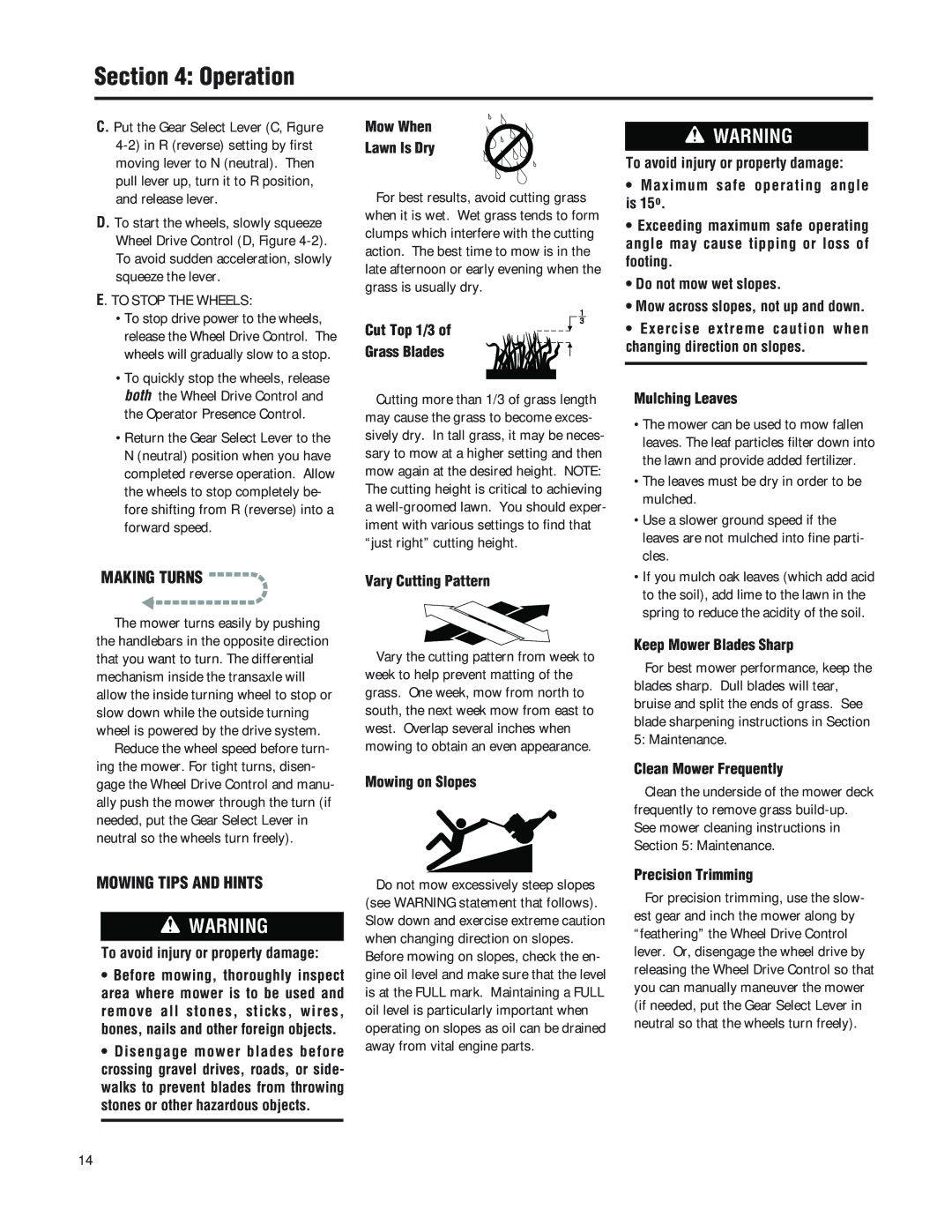
Section 4: Operation
C. Put the Gear Select Lever (C, Figure
D. To start the wheels, slowly squeeze Wheel Drive Control (D, Figure
E. TO STOP THE WHEELS:
•To stop drive power to the wheels, release the Wheel Drive Control. The wheels will gradually slow to a stop.
•To quickly stop the wheels, release both the Wheel Drive Control and the Operator Presence Control.
•Return the Gear Select Lever to the N (neutral) position when you have completed reverse operation. Allow the wheels to stop completely be- fore shifting from R (reverse) into a forward speed.
MAKING TURNS
The mower turns easily by pushing the handlebars in the opposite direction that you want to turn. The differential mechanism inside the transaxle will allow the inside turning wheel to stop or slow down while the outside turning wheel is powered by the drive system.
Reduce the wheel speed before turn- ing the mower. For tight turns, disen- gage the Wheel Drive Control and manu- ally push the mower through the turn (if needed, put the Gear Select Lever in neutral so the wheels turn freely).
MOWING TIPS AND HINTS
WARNING
To avoid injury or property damage:
•Before mowing, thoroughly inspect area where mower is to be used and remove all stones, sticks, wires, bones, nails and other foreign objects.
•Disengage mower blades before crossing gravel drives, roads, or side- walks to prevent blades from throwing stones or other hazardous objects.
Mow When
Lawn Is Dry
For best results, avoid cutting grass when it is wet. Wet grass tends to form clumps which interfere with the cutting action. The best time to mow is in the late afternoon or early evening when the grass is usually dry.
1
3
Cut Top 1/3 of
Grass Blades
Cutting more than 1/3 of grass length may cause the grass to become exces- sively dry. In tall grass, it may be neces- sary to mow at a higher setting and then mow again at the desired height. NOTE: The cutting height is critical to achieving a
Vary Cutting Pattern
Vary the cutting pattern from week to week to help prevent matting of the grass. One week, mow from north to south, the next week mow from east to west. Overlap several inches when mowing to obtain an even appearance.
Mowing on Slopes
Do not mow excessively steep slopes (see WARNING statement that follows). Slow down and exercise extreme caution when changing direction on slopes. Before mowing on slopes, check the en- gine oil level and make sure that the level is at the FULL mark. Maintaining a FULL oil level is particularly important when operating on slopes as oil can be drained away from vital engine parts.
WARNING
To avoid injury or property damage:
•Maximum safe operating angle is 15o.
•Exceeding maximum safe operating angle may cause tipping or loss of footing.
•Do not mow wet slopes.
•Mow across slopes, not up and down.
•Exercise extreme caution when changing direction on slopes.
Mulching Leaves
•The mower can be used to mow fallen leaves. The leaf particles filter down into the lawn and provide added fertilizer.
•The leaves must be dry in order to be mulched.
•Use a slower ground speed if the leaves are not mulched into fine parti- cles.
•If you mulch oak leaves (which add acid to the soil), add lime to the lawn in the spring to reduce the acidity of the soil.
Keep Mower Blades Sharp
For best mower performance, keep the blades sharp. Dull blades will tear, bruise and split the ends of grass. See blade sharpening instructions in Section 5: Maintenance.
Clean Mower Frequently
Clean the underside of the mower deck frequently to remove grass
Precision Trimming
For precision trimming, use the slow- est gear and inch the mower along by “feathering” the Wheel Drive Control lever. Or, disengage the wheel drive by releasing the Wheel Drive Control so that you can manually maneuver the mower (if needed, put the Gear Select Lever in neutral so that the wheels turn freely).
14
